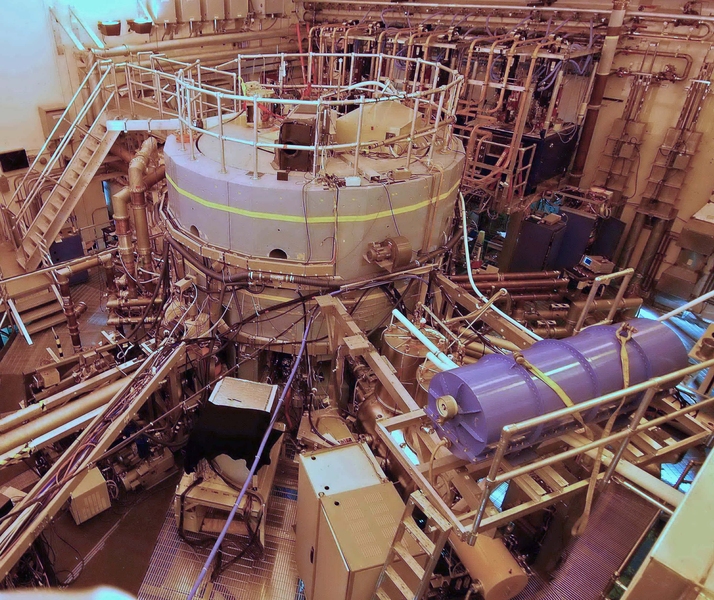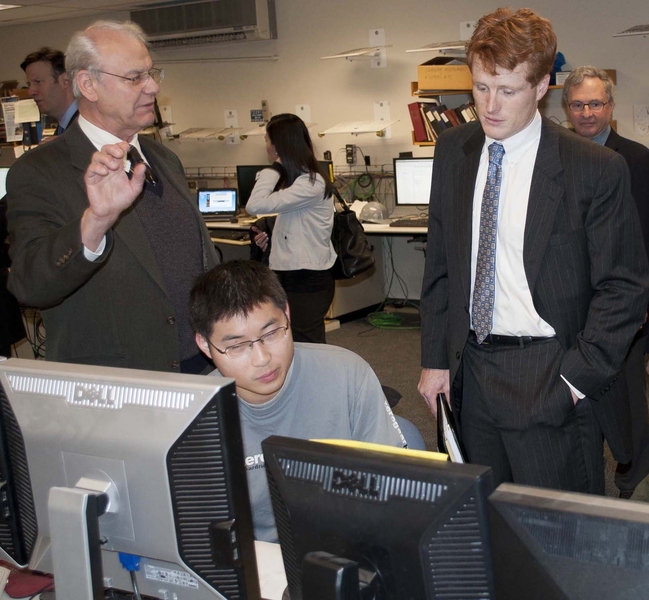Students, staff, and researchers at MIT’s Plasma Science and Fusion Center (PSFC) learned this week that the 2014 U.S. budget, passed by Congress and signed into law last week by President Barack Obama, includes the first funding in more than a year for the research operations of MIT’s national fusion project, Alcator C-Mod.
The project, which was designated for closeout in the adminstration's fiscal 2013 budget proposal, released in February 2012, was upgraded to "warm shutdown" status in June 2013, allowing the PSFC to sustain staff and engage in collaborations with other laboratories, but with no funding to run the C-Mod facility that year. PSFC students, faculty, and research staff have not been able to run experiments or collect new data since October 2012.
The new funding is expected to support experimental research operations for at least 12 weeks in the current fiscal year.
“We are extremely pleased that we can resume the critical research of our team, exploring key regimes of plasma transport, radio-frequency heating and current drive, and plasma-material interactions, as we push the frontiers of plasma science and engineering on the path to developing practical energy from nuclear fusion,” says Earl Marmar, a senior research scientist in the Department of Physics and head of the Alcator Project. “This also provides an important opportunity for our graduate students to fill in key experimental gaps in their research that were left open by the abrupt proposal to stop operations.”

From the control room, graduate students perform experiments on the Alcator C-Mod tokamak to support their thesis work. Photo: Paul Rivenberg/Mary Pat McNally
In its most recent report on priorities for domestic magnetic fusion research, the Department of Energy’s Fusion Energy Sciences Advisory Committee (FESAC) criticized the previous cuts to the domestic fusion budget and recommended that resumption of C-Mod operation, for three to five years, should be the top priority for any incremental funds in the program.
Miklos Porkolab, a professor of physics and director of the PSFC, hopes that funding will continue beyond September 2014.
“It is essential that we continue to offer a stable fusion program at MIT for graduate students,” Porkolab says. “MIT has been at the forefront of graduate education in plasma physics and fusion science and engineering since the 1960s. We have a very strong and unique technical program based on upgrades to C-Mod that would ensure cutting-edge research for the next three to five years, as recommended by FESAC.”
Porkolab adds that the new funding should also benefit operations at ITER, the world’s largest fusion experiment, under construction in France and supported by an international consortium of seven nations, including the U.S., to demonstrate the scientific feasibility of fusion in the laboratory.
“This research would help optimize ITER operations, and would have important applications to fusion power plants beyond ITER,” he says.
The project, which was designated for closeout in the adminstration's fiscal 2013 budget proposal, released in February 2012, was upgraded to "warm shutdown" status in June 2013, allowing the PSFC to sustain staff and engage in collaborations with other laboratories, but with no funding to run the C-Mod facility that year. PSFC students, faculty, and research staff have not been able to run experiments or collect new data since October 2012.
The new funding is expected to support experimental research operations for at least 12 weeks in the current fiscal year.
“We are extremely pleased that we can resume the critical research of our team, exploring key regimes of plasma transport, radio-frequency heating and current drive, and plasma-material interactions, as we push the frontiers of plasma science and engineering on the path to developing practical energy from nuclear fusion,” says Earl Marmar, a senior research scientist in the Department of Physics and head of the Alcator Project. “This also provides an important opportunity for our graduate students to fill in key experimental gaps in their research that were left open by the abrupt proposal to stop operations.”

From the control room, graduate students perform experiments on the Alcator C-Mod tokamak to support their thesis work. Photo: Paul Rivenberg/Mary Pat McNally
In its most recent report on priorities for domestic magnetic fusion research, the Department of Energy’s Fusion Energy Sciences Advisory Committee (FESAC) criticized the previous cuts to the domestic fusion budget and recommended that resumption of C-Mod operation, for three to five years, should be the top priority for any incremental funds in the program.
Miklos Porkolab, a professor of physics and director of the PSFC, hopes that funding will continue beyond September 2014.
“It is essential that we continue to offer a stable fusion program at MIT for graduate students,” Porkolab says. “MIT has been at the forefront of graduate education in plasma physics and fusion science and engineering since the 1960s. We have a very strong and unique technical program based on upgrades to C-Mod that would ensure cutting-edge research for the next three to five years, as recommended by FESAC.”
Porkolab adds that the new funding should also benefit operations at ITER, the world’s largest fusion experiment, under construction in France and supported by an international consortium of seven nations, including the U.S., to demonstrate the scientific feasibility of fusion in the laboratory.
“This research would help optimize ITER operations, and would have important applications to fusion power plants beyond ITER,” he says.







